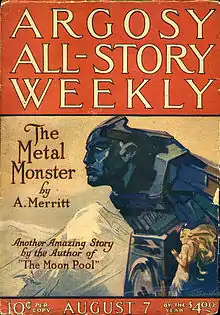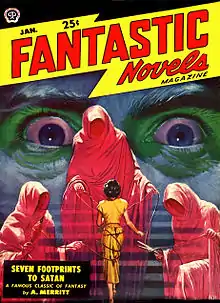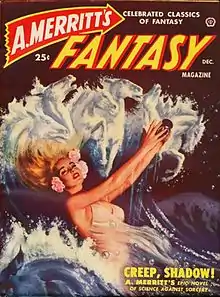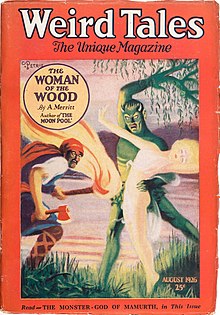A. Merritt
Abraham Grace Merritt (January 20, 1884 – August 21, 1943) – known by his byline, A. Merritt – was an American Sunday magazine editor and a writer of fantastic fiction.[1]
A. Merritt | |
|---|---|
 Merritt circa 1920 | |
| Born | Abraham Grace Merritt January 20, 1884 Beverly, New Jersey, US |
| Died | August 21, 1943 (aged 59) Indian Rocks Beach, Florida, US |
| Pen name | W. Fenimore (one 1923 story) |
| Occupation | Journalist, writer |
| Period | 1917–1943 (fiction) |
| Genre | Speculative fiction, supernatural fiction |
| Subject | Weekly news supplement |
The Science Fiction and Fantasy Hall of Fame inducted him in 1999, its fourth class of two deceased and two living writers.[2]
Life
Born in Beverly, New Jersey, he moved to Philadelphia, Pennsylvania in 1894.[3] Originally trained in law, he turned to journalism, first as a correspondent and later as editor. According to Peter Haining, Merritt survived a harrowing experience while a young reporter at The Philadelphia Inquirer about which he refused to ever speak, but would, as Haining claims, mark a turning point in Merritt's life. He was assistant editor of The American Weekly from 1912 to 1937 under Morrill Goddard, then its editor from 1937 until his death. As editor, he hired the unheralded new artists Virgil Finlay and Hannes Bok and promoted the work done on polio by Sister Elizabeth Kenny.
His fiction, eight complete novels and a number of short stories,[4] was only a sideline to his journalism career. One of the best-paid journalists of his era, Merritt made $25,000 per year by 1919, and at the end of his life was earning $100,000 yearly—exceptional sums for the period. His financial success allowed him to pursue world travel—he invested in real estate in Jamaica and Ecuador—and exotic hobbies, like cultivating orchids and plants linked to witchcraft and magic (monkshood, wolfbane, blue datura, peyote, and cannabis).[5]
He was described as a hypochondriac who talked endlessly about his medical symptoms, and showed eccentric behavior like a need to try out any food, tobacco and medicine he found on his coworkers desks. Occasionally he would dress in a kilt and play serenades for his coworkers with some of his huge collection of instruments he kept in a locked closet at work. He was well liked for his fairness and inability to fire any employees.[6]
Merritt married twice, once in the 1910s to Eleanore Ratcliffe, with whom he raised an adopted daughter, and again in the 1930s to Eleanor H. Johnson. He lived in the Hollis Park Gardens neighborhood of Queens, New York City, where he accumulated collections of weapons, carvings, and primitive masks from his travels, as well as a library of occult literature that reportedly exceeded 5000 volumes. He died suddenly of a heart attack, at his winter home in Indian Rocks Beach, Florida, in 1943.
Writing
Merritt's writings were heavily influenced by H. Rider Haggard,[7] Robert W. Chambers,[8] Helena Blavatsky[9] and Gertrude Barrows Bennett (writing as Francis Stevens),[10] with Merritt having "emulated Bennett's earlier style and themes."[10] Merritt's stories typically revolve around conventional pulp magazine themes: lost civilizations, hideous monsters, etc. His heroes are gallant Irishmen or Scandinavians, his villains treacherous Germans or Russians and his heroines often virginal, mysterious and scantily clad.
What sets Merritt apart from the typical pulp author, however, is his lush, florid prose style and his exhaustive, at times exhausting, penchant for adjective-laden detail. Merritt's fondness for micro-description nicely complements the pointillistic style of Bok's illustrations.

Merritt's first fantasy story was published in 1917, "Through the Dragon Glass" in the November 14 issue of Frank Munsey's All-Story Weekly.[11] Other short stories and serial novels followed in the Munsey magazines All-Story, Argosy All-Story, and Argosy:[lower-alpha 1] The People of the Pit (1918), "The Moon Pool" (1918), The Conquest of the Moon Pool (1919), "Three Lines of Old French" (1919), The Metal Monster (1920), The Face in the Abyss (1923), The Ship of Ishtar (1924), Seven Footprints to Satan (1927), The Snake Mother (1930), Burn Witch Burn! (1932), Dwellers in the Mirage (1932), and Creep, Shadow! (1934).[11] Meanwhile, rather few of his stories appeared elsewhere: The Pool of the Stone God (in his own American Weekly, 1923), The Woman of the Wood (Weird Tales, 1926), The Metal Emperor (Science and Invention, 1927), and The Drone Man (Fantasy Magazine, 1934).[11]
Merritt also contributed to the round robin story The Challenge from Beyond with Lovecraft, Robert E. Howard, C. L. Moore, and Frank Belknap Long.
The Fox Woman and the Blue Pagoda (1946) combined an unfinished story with a conclusion written by Merritt's friend Hannes Bok. The Fox Woman and Other Stories (1949) collected the same fragment, minus Bok's conclusion, with Merritt's short stories. The book The Black Wheel was published in 1948, after Merritt's death; it was written by Bok using previously unpublished material as well. Both these books were also illustrated by Bok and published by the small press The New Collectors Group in hardcover.
After Merritt's death, Sam Moskowitz discovered a number of poems among his papers. Though some may have been written by other authors, they were credited to Merritt when published.[12]
Reputation
Merritt was a major influence on H. P. Lovecraft[13][14] and Richard Shaver,[15] and highly esteemed by his friend and frequent collaborator Hannes Bok, a science fiction illustrator. Karl Edward Wagner included Burn Witch Burn on his list of "The Thirteen Best Supernatural Horror Novels" in the May 1983 issue of The Twilight Zone Magazine.[16] Michael Moorcock and James Cawthorn list The Ship of Ishtar and Dwellers in the Mirage as two of the novels in their book Fantasy: the 100 Best Books, describing the former book as Merritt "at the peak of his powers", and Merritt's work as a whole being full of "memorable images".[17] Robert Bloch also included Burn Witch Burn on his list of favourite horror novels.[18] Gary Gygax, co-creator of the game Dungeons & Dragons, listed Merritt in "Appendix N" of the Dungeon Masters Guide and often noted that he was one of his favorite fantasy authors.[19] In the Lensman series by E. E. Smith, there is a reference to the novel Dwellers in the Mirage in which the protagonist Kimball Kinnison references the book and a quotation from it "Luka—turn your wheel so I need not slay this woman!"
Work
Novels


- The Moon Pool (fix-up, 1919) Available online
(The Moon Pool (1918) + Conquest of the Moon Pool (1919)) - The Metal Monster (1920) Available online
- The Ship of Ishtar (1924) Available online
- Seven Footprints to Satan (1927) Available online
- The Face in the Abyss (fix-up, 1931) Available online
(The Face in the Abyss (1923) + The Snake Mother (1930)) - Dwellers in the Mirage (1932) Available online
- Burn, Witch, Burn! (1932) Available online
- Creep, Shadow! (1934) Available online
Short stories
- "Through The Dragon Glass" (1917) Available online
- "The People of the Pit" (1918) Available online
- "Three Lines of Old French" (1919) Available online
- "Prologue" (The Metal Monster, 1920)
- The Pool of the Stone God (as W. Fenimore, 1923) Available online
- "The Women of the Wood" (1926) Available online
- "The Drone" (also known as "The Drone Man", 1934) Available online
- "The Rhythm of the Spheres" (originally a chapter called "The Last Poet and the Robots" or "The Last Poet & the Wrongness of Space" in the 1934 round robin novel titled Cosmos, revised in 1936 as a stand-alone work) Available online

- "The Whelming of Cherkis" (excerpt from The Metal Monster, 1946)
- "When Old Gods Wake" (fragment, 1948) Available online
- "The White Road" (fragment, 1949) Available online
- "The Fox Woman" (incomplete, 1949) Available online
- "Pilgrimage, or, Obi Giese" (1985)
- "Bootleg and Witches" (fragment, 1985)
- "The Devil in the Heart" (outline, 1985)
- "The Dwellers in the Mirage" (original ending of the novel with same name, 1985)
Short story collections
- The Fox Woman and Other Stories (1949)
- The Fox Woman, 1946
- The People of the Pit, 1917
- Through the Dragon Glass, 1917
- The Drone, 1934
- The Last Poet and the Robots, 1934
- Three Lines of Old French, 1919
- The White Road, 1949
- When Old Gods Wake, 1948
- The Woman of the Wood, 1934
Poems
- "Song for Wood Horns" (also known as "The Wind Trail", 1910)
- "The Silver Birches" (1940)
- "Old Trinity Churchyard" (5 A. M. Spring) (1941)
- "Sylvane – The Silver Birches" (1973)
- "In the Cathedral" (1974)
- "2000 (The Triple Cities)" (1985)
- "Song for Wood Horn..." (1985)
- "Silvane—The Silver Birches" (1985)
- "Madonna" (1985)
- "The Ladies of the Walnut Tree (A Legend of Tuscany)" (fragments, 1985)
- "Court of the Moon" (fragment, 1985)
- "The Birth of Art" (1985)
- "L'envoi to Life" (1985)
- "Screens" (1985)
- "Sir Barnabas" (1985)
- "In the Subway" (1985)
- "Runes" (1985)
- "Eheu Fugaces..." (1985)
- "A Song for Christmas" (1985)
- "Comic Ragtime Tune" (1985)
- "Behold the Night He Cometh" (1985)
- "You Looked at Me" (1985)
- "Dream Song" (1985)
- "Castle of Dreams" (1985)
- "I Wonder Why?" (1985)
- "My Heart and I" (1985)
- Think of Me (1985)
- "The Ballad of the Cub" (1985)
- "Piddling Pete" (1985)
- "The Winged Flames" (1985)
Collaborations
- "The Challenge from Beyond" (round robin short story, with C.L. Moore, H.P. Lovecraft, Robert E. Howard, and Frank Belknap Long, 1935) Available online
- Cosmos (round robin novel, chapter 11, 1932–34) Available online
- The Fox Woman and the Blue Pagoda (novel, Hannes Bok fused Merritt's unfinished story with his own conclusion, 1946)
- The Black Wheel (novel, first seven chapters written by Merritt, completed by Hannes Bok, 1947)
Essays
- A. Merritt on Modern Witchcraft (1932)
- Concerning "Burn, Witch, Burn" (1932)
- Letter (Weird Tales, November 1935) (1935)
- Man and the Universe (1940)
- A. Merritt (1940)
- How We Found Circe (1942)
- A Tribute (1942)
- Letter to Mr. Louis De Casanova, July 23, 1931 (1985)
- Letters and Correspondence (1985)
- An Autobiography of A. Merritt (1985) with Walter Wentz
- A. Merritt—His Life and Times (1985) with Jack Chapman Miske
- What is Fantasy? (1985)
- Background of "Dwellers in the Mirage" (1985)
- Background of "Burn, Witch, Burn" (1985)
- Background of "Creep, Shadow!" (1985)
- A. Merritt's Own Selected Credo (1985)
Adaptations
Merritt's work has been adapted only rarely for films. These include:
- Seven Footprints to Satan (1929), adapted from the novel of the same name and directed by Benjamin Christensen.
- The Devil-Doll (1936), adapted from the novel Burn Witch Burn! and directed by Tod Browning.
- Muñecos infernales (1961), adapted from the novel Burn Witch Burn! (uncredited) and directed by Benito Alazraki.[21]
See also
Notes
- All-Story and Munsey's much older magazine The Argosy were merged in August 1920, as Argosy All-Story Weekly. The Frank Munsey Company magazines were reorganized again in October 1929 (four years after Munsey's death), after which Merritt's stories appeared in the weekly Argosy.[lower-alpha 2][lower-alpha 3]
- Series bibliographies: "Argosy" (to 1920, from 1929); "All-Story Magazine" (1905–1920); "Argosy All-Story Weekly" (1920–1929). ISFDB. Retrieved 2013-04-23.
References
- Haining, Peter (1998). 20th Century Ghost Stories. Robinson Publishing.
- "Science Fiction and Fantasy Hall of Fame" Archived May 21, 2013, at the Wayback Machine. Mid American Science Fiction and Fantasy Conventions, Inc. Retrieved 2013-03-26. This was the official website of the hall of fame to 2004.
- Merritt, Abraham; Levy, Michael M. The Moon Pool, p. 303. Wesleyan University Press, 2004. ISBN 0819567078. "Abraham Grace Merritt was born on January 20, 1884, in Beverly, New Jersey, a small town outside of Philadelphia."
- Encyclopedia of Pulp Fiction Writers
- Moskowitz, Sam. A. Merritt: Reflections in the Moon Pool. Philadelphia, Oswald Train, 1985. ISBN 99962-4-760-0
- The Moon Pool
- Lee Server, Encyclopedia of Pulp Fiction Writers, Facts on File Inc (2002), p.131.
- E. F. Bleiler, "A.Merritt", in Bleiler, ed. Supernatural Fiction Writers. New York: Scribner's, 1985, pp.835–844. ISBN 0-684-17808-7
- The Moon Pool – Introduction by Michael Levy
- Partners in Wonder: Women and the Birth of Science Fiction, 1926–1965 by Eric Leif Davin, Lexington Books, 2005, pages 409–10.
- A. Merritt at the Internet Speculative Fiction Database (ISFDB). Retrieved 2013-04-23.
- The Moon Pool
- "I was extremely glad to meet Merritt in person, for I have admired his work for 15 years. ... he has a peculiar power of working up an atmosphere and investing a region with an aura of unholy dread" H.P. Lovecraft's letter to R. H. Barlow (January 13, 1934)
- "Merritt, A[braham]" in An H.P. Lovecraft encyclopedia (2001) page 167. ISBN 0-313-31578-7
- Skinner, Doug (August 2005). "What's This? A Shaver Revival?". Fate. Archived from the original on August 23, 2009. Retrieved August 26, 2009.
Shaver's main literary model was Abraham Merritt. Merritt isn't read much today, but his fantasy novels were quite popular throughout the '20s and '30s. Beginning with The Moon Pool in 1919, he produced a series of novels about caverns, lost races, ancient ray machines, shell-shaped hovercraft, and other marvels. He was also a member of the original Fortean Society and the editor of The American Weekly, a Sunday newspaper supplement that often featured scientific and historical oddities. Shaver thought Merritt had seen the caves but could only mention them in fiction. One might also suspect that Merritt's novels had influenced Shaver's beliefs.
- N. G. Christakos, "Three By Thirteen: The Karl Edward Wagner Lists" in Black Prometheus: A Critical Study of Karl Edward Wagner, ed. Benjamin Szumskyj, Gothic Press 2007. ISBN 978-0913045145
- Moorcock and Cawthorn, Fantasy: The 100 Best Books, Carroll & Graf, (1988), p. 81-2,93-4.
- Robert Bloch, "Robert Bloch's Ten Favorite Horror-Fantasy Novels" in The Book of Lists : Horror. Amy Wallace, Scott Bradley, and Del Howison, New York : Harper, 2008. ISBN 9780061537264 (p. 253)
- "Forgotten Father", James Maliszewski, Grognardia, January 20, 2010.
- The Supernatural Index: A Listing of Fantasy, Supernatural, Occult, Weird, and Horror Anthologies
- Also known as The Curse of the Doll People, this Mexican horror film is usually said to have been inspired by Tod Browning's The Devil-Doll. A closer examination shows that it was adapted directly from Merritt's novel. The film includes many characters, situations, scenes and speeches from the novel, none of which are present in The Devil-Doll. The film does not credit Merritt with the story; it gives that honor to screenplay author Alfredo Salazar instead.
Further reading
- Foust, Ronald (1989) A. Merritt. Starmont Reader's Guide #43. 104 pages. ISBN 0-930261-36-4
- Guillaud, Lauric (1993) L'aventure mystérieuse de Poe à Merritt ou l'orphelins de Gilgamesh. Paralittératures Volume 3. Editions du CEFAL. ISBN 2-87130-035-6
- Indick, Ben P. A . Merritt: A Reappraisal in Darrell Schweitzer (ed), Discovering Classic Fantasy Fiction, Gillette NJ: Wildside Press, 1986, pp. 87.
External links
- "Abraham Merritt biography". Science Fiction and Fantasy Hall of Fame.
- A. Merritt at the Internet Speculative Fiction Database
- Abraham Merritt at the Internet Book List
- Works by A. Merritt in eBook form at Standard Ebooks
- Works by Abraham Merritt at Project Gutenberg
- Works by Abraham Merritt at Faded Page (Canada)
- Works by Abraham Merritt at Digital Archive (Toronto Public Library)
- Works by or about A. Merritt at Internet Archive
- Works by A. Merritt at LibriVox (public domain audiobooks)

- Abraham Merritt at Project Gutenberg Australia
- Abraham Merritt at Locus Magazine's Index to Science Fiction
- MERRITT, A(braham Grace) Archived October 25, 2020, at the Wayback Machine at the Index to Science Fiction Anthologies and Collections, Combined Edition
- Abraham Merritt at the FictionMags Index
- Abraham Merritt at Fantastic Fiction
- Works by Abraham Merritt at Open Library
- Abraham Merritt at IMDb